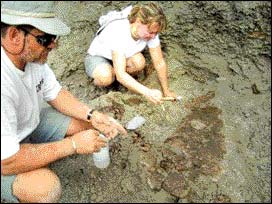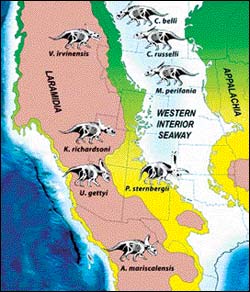|
Two-horned dinosaur
fossils unearthed
Two remarkable new species of horned dinosaurs have been found in
Grand Staircase-Escalante National Monument, southern Utah. The giant
plant-eaters were inhabitants of the "lost continent" of Laramidia,
formed when a shallow sea flooded the central region of North America,
isolating the eastern and western portions of the continent for millions
of years during the Late Cretaceous Period. The newly discovered
dinosaurs, close relatives of the famous Triceratops, were announced
late last month in PLoS ONE, the online open-access journal produced by
the Public Library of Science.
  The
study, , was led by Scott Sampson and Mark Loewen of the Utah Museum of
Natural History (UMNH) and Department of Geology and Geophysics,
University of Utah. The bigger of the two new dinosaurs, with a skull
2.3 meters (about 7 feet) long, is Utahceratops gettyi (U-tah-SARA-tops
get-EE-i). The first part of the name combines the state of origin with
ceratops, Greek for "horned face." The second part of the name honours
Mike Getty, paleontology collections manager at the Utah Museum of
Natural History and the discoverer of this animal. In addition to a
large horn over the nose, Utahceratops has short and blunt eye horns
that project strongly to the side rather than upward, much more like the
horns of modern bison than those of Triceratops or other ceratopsians.
Mark Loewen, one of the authors on the paper, likened Utahceratops to "a
giant rhino with a ridiculously supersized head." The
study, , was led by Scott Sampson and Mark Loewen of the Utah Museum of
Natural History (UMNH) and Department of Geology and Geophysics,
University of Utah. The bigger of the two new dinosaurs, with a skull
2.3 meters (about 7 feet) long, is Utahceratops gettyi (U-tah-SARA-tops
get-EE-i). The first part of the name combines the state of origin with
ceratops, Greek for "horned face." The second part of the name honours
Mike Getty, paleontology collections manager at the Utah Museum of
Natural History and the discoverer of this animal. In addition to a
large horn over the nose, Utahceratops has short and blunt eye horns
that project strongly to the side rather than upward, much more like the
horns of modern bison than those of Triceratops or other ceratopsians.
Mark Loewen, one of the authors on the paper, likened Utahceratops to "a
giant rhino with a ridiculously supersized head."
Second of the new species is Kosmoceratops richardsoni (KOZ-mo-SARA-tops
RICH-ard-SON-i). Here, the first part of the name refers to kosmos,
Latin for "ornate," and ceratops, once again meaning "horned face." The
latter part of the name honours Scott Richardson, the volunteer who
discovered two skulls of this animal. Kosmoceratops also has sideways
oriented eye horns, although much longer and more pointed than in
Utahceratops.
In all, Kosmoceratops possesses a total of 15 horns-one over the
nose, one atop each eye, one at the tip of each cheek bone, and ten
across the rear margin of the bony frill-making it the most
ornate-headed dinosaur known. Scott Sampson, the paper's lead author,
claimed that, "Kosmoceratops is one of the most amazing animals known,
with a huge skull decorated with an assortment of bony bells and
whistles."
The dinosaurs were discovered in Grand Staircase-Escalante National
Monument (GSENM), which encompasses 1.9 million acres of high desert
terrain in south-central Utah. This vast and rugged region, part of the
National Landscape Conservation System administered by the Bureau of
Land Management, was the last major area in the lower 48 states to be
formally mapped by cartographers. Grand Staircase-Escalante National
Monument is now one of the country's last great, largely unexplored
dinosaur boneyards.
- Courtesy: Science Daily |

